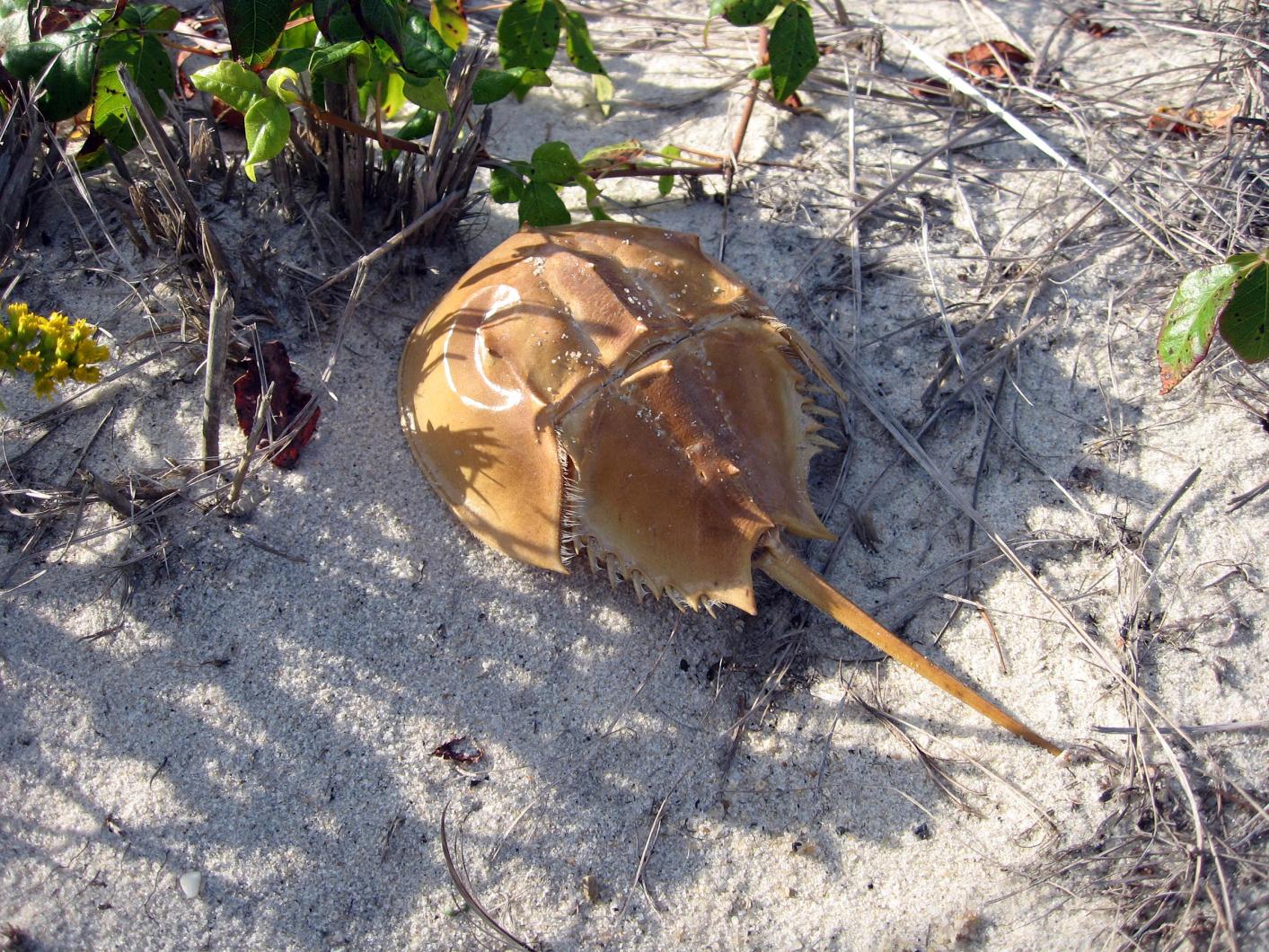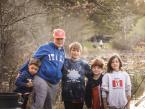Among all the species taken by fishermen in this part of the world, horseshoe crabs have, until now, enjoyed a dubious distinction: they were the only ones targeted while in the act of reproducing.
The easiest way for many to catch them was to walk the beaches at the times of the full and new moons in May and June and simply pick them up as they came into the shallows to spawn.
Not anymore though. As of this year, new regulations will stop the practice. For five days around each full and new moon, they will be left undisturbed as they sow future generations of themselves. A new minimum size limit also has been established.
And the consequences could be significant, not just for the primitive, helmet-shaped creatures themselves, but for the biggest-value fishery on the Vineyard, the conch fishery, which accumulating evidence suggests is fully fished, if not over-fished already,
Horseshoe crabs are harvested for two purposes. One is that they are the best-known bait for conch. The other is that their blood yields a product of huge importance to human medicine, the best means of detecting bacterial contamination. Anything that’s injected or implanted into a human body is tested with this extract of horseshoe crab blood.
It is the former use that is more relevant to the Island, for the ones taken here are used overwhelmingly, if not exclusively, for bait. And in an environment where most fisheries are in decline and/or tightly regulated, the conch fishery is a rare growth story.
Conch — more properly channeled whelk — are a kind of large carnivorous snail which has become the basis of a $3 million fishery. The quantities landed have increased around 60 per cent, just in the past three years.
And there are signs that conch, like horseshoe crabs, are being over-exploited. But first, about the crabs.
Horseshoe crabs are fascinating creatures. In fact they are not really crabs at all — their closest living relatives are arachnids, like spiders and ticks. In the spring, when the tides are highest around the full and new moons, they come in to mate. The male grabs the female with special pincers, and is dragged behind her to a beach, where she makes a nest and lays eggs. She then moves forward so he can fertilize them. They may repeat this process several times in a cycle.
They have existed essentially unchanged for some 230 million years.
From a fisheries management perspective, the salient fact is not their long history, but their limited geography. Horseshoe crabs have no planktonic stage of development; they don’t disperse in the current to be carried far away. They live out their lives where they were born.
What this means is that if you reduce a population in one area, it will not be repopulated by migration from somewhere else. Thus they are at risk of being wiped out in specific locations, area by area. The regulators at the Division of Marine Fisheries (DMF) call it serial depletion.
This makes it hard to compile data on population numbers. And, in truth, there has not been much work done on getting that data.
Over the past couple of years efforts have been made at organized counts; the regular DMF trawl surveys have noted a decline in numbers over eight or nine years. But much of the evidence is anecdotal. There just don’t seem to be nearly as many as there used to be. And it’s clear the conch fishermen were taking enormous numbers.
Susan Bowman, who directed last year’s survey of crab numbers, said she had witnessed numerous complete “cleanings” of spawning beaches, where every single crab her volunteers counted was gathered up for bait.
She now is organizing this year’s crab-counting endeavor, which will involve 24 separate surveys during May and June. Volunteers will be trained in surveying methods this Tuesday from 10 am to noon and next Saturday from 1 to 3 p.m. Volunteers can contact Felix Neck sanctuary for more information.
“This is severely threatening the future of these animals at the cost of very short-term profits,” Ms. Bowman wrote in her submission to the DMF review which led to the new regulations.
A lot of Island fishermen did not see it that way. In its submission, the Dukes County Martha’s Vineyard Fishermen’s Association opposed any tightening of the rules.
“The horseshoe crab fishery has been very successful for us and is one of the mainstays of our commercial fishery. We urge you not to set new rules that will end our supply of good, fresh, local bait,” the association letter said.
There were regulations enough already with weekend closures, a 400-crab-per-day limit.
One of the directors of the fishermen’s association, Warren Doty, elaborated to the Gazette, saying the organization did not think there was enough evidence of depleted stocks.
The fact that the changes had been implemented against the wishes of local fishermen meant they would “really have to scramble to find bait” now, he said.
More would no doubt be imported to the Island, and fishermen were experimenting with other baits.
“Our most interesting alternative is the green crab, which we are removing from our coastal ponds as predators,” he said. “Using them as bait in the conch fishery would kill two birds with one stone.”
But that is still a maybe. What is certain is that the supply of bait is going to be tight. The DMF estimates some 40 per cent of the total catch last year was taken during the full and new moon periods which are now closed.
Dan McKiernan, deputy director of the DMF, suggested the effect on bait supplies might not be that drastic, and that more of the horseshoe crabs which now are caught solely for bait will instead be used twice. First they will be bled for the pharmaceutical trade, then used for bait.
To date the bait and pharmaceutical catches have largely been separate. The Massachusetts biomedical firm which uses the crabs has a system by which they are caught, bled and then released again.
But even here, the recent news has not been good. A DMF study showed there was a mortality rate of up to 30 per cent in that process, around twice what the firm claims. Also, in an effort to address possible bait shortages, the state has increased the number of crabs which can be taken by trawlers, from July, outside the spawning season, from 400 to 600
As for conch, like horseshoe crabs, they have no planktonic stage. Like horseshoe crabs, they exist in scattered, separate populations. And like the crabs, this makes them vulnerable to serial depletion.
And that already appears to be happening.
The take from one of the major fishing areas in Massachusetts, Buzzards Bay, precipitously dropped by about 40 per cent between 2005 and 2006, and in 2007 was down more than 50 per cent from its peak.
That decline, however, was more than compensated by increased fishing effort in Nantucket and Vineyard Sounds, where total landings went up more than 100 per cent between 2005 and 2008.
“We think that the extra fishing that has taken place, fishermen are more dependent on this because of the decline of lobsters,” said Mr. McKiernan, adding:
“Conch has been the fishery of last resort.
“With fishermen scrambling because of declines in other species, reductions in quotas, they’ll often gravitate to the species that is wide open to them. And up until now, the conch fishery was relatively open.”
But perhaps no more. The DMF study into the decline in horseshoe crab numbers noted the conch fishery as a contributor and promised to work to address the sustainability of it. Until those studies are complete, the DMF has placed an indefinite freeze on all permit transfers for conch license transfers.
“We are concerned there is a potential for serial depletion of conch as of horseshoe crabs,” said Mr. McKiernan.
He said some Island fishermen also were concerned, and had themselves proposed an increased minimum size for conch.
“We don’t think there’s room for more conch fishing than we have now,” he said.
It’s not good news for the fishery of last resort.







Comments (2)
Comments
Comment policy »